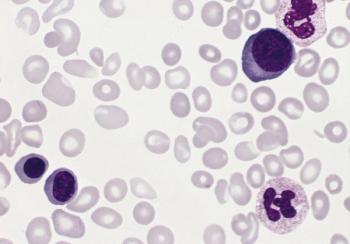
Clinical
Latest News

Latest Videos
CME Content
More News

Results for IRAKLIA show noninferiority for Sanofi's on-body delivery system for isatuximab, compared with IV administration. Patients overwhelmingly preferred the hands-free delivery option.

Ivarmacitinib, also known as oral SHR0302, is not yet approved by the FDA, with trials currently exploring its utility in disease settings that include atopic dermatitis and rheumatoid arthritis.

Panelists discuss how ADA recommendations emphasize treating diabetes as part of overlapping conditions requiring cardiovascular and kidney protection, moving beyond just glycemic control to comprehensive care that addresses the whole person.

Panelists discuss how hormonal adaptations during weight loss in diabetes patients improve insulin sensitivity, while the DiRECT trial demonstrates that structured weight management programs can achieve diabetes remission in nearly half of newly diagnosed patients.

Inhaled corticosteroid (ICS) use was common among patients with bronchiectasis and was associated with reduced exacerbations and hospitalizations in those with elevated blood eosinophil counts.

Panelists discuss how disease progression monitoring requires integrating multiple data points including symptoms, six-minute walk tests, biomarkers like BNP/NT-proBNP, and imaging studies, with risk stratification tools helping guide treatment decisions while considering individual patient characteristics.

Panelists discuss how early detection barriers include nonspecific symptoms like progressive dyspnea that are often misattributed to more common conditions, leading to delayed diagnosis and the need for improved diagnostic algorithms using biomarkers and imaging.

In May, the FDA granted significant drug approvals across various therapeutic areas, marking notable progress in expanding treatment options for patients.

A panelist discusses how ITP diagnosis remains one of exclusion requiring thorough testing to rule out other causes of thrombocytopenia, followed by patient education about autoimmune diseases and bleeding symptoms like nosebleeds, bruising, and petechiae.

Patients with myelodysplastic syndrome (MDS) who received luspatercept showed greater hemoglobin gains and transfusion independence compared with erythropoiesis-stimulating agents (ESAs) in a real-world analysis.

The 2025 European Hematology Association (EHA) Congress, convening virtually and in Milan, Italy, from June 12 to June 15, 2025, will feature a revamped program structure for the meeting’s 30th anniversary while maintaining ample opportunities to network, debate, and absorb practice-changing findings in hematology and oncology.

The PURPOSE trials illuminated the ways in which lenacapavir could be used as a means of pre-exposure prophylaxis effectively, but also featured several adverse events.

Brian Slomovitz, MD, of Mount Sinai Medical Center, compares relacorilant plus nab-paclitaxel with existing treatments for platinum-resistant ovarian cancer and highlights the ROSELLA trial’s global scope.

Panelists discuss how disease progression despite treatment in older patients with spinal muscular atrophy (SMA) may be due to natural aging effects combined with SMA, not necessarily treatment failure, highlighting the importance of exercise, nutrition, and management of contractures.

Panelists discuss how health systems can learn from published case examples when implementing biosimilars, noting that biosimilars can create a “win-win” situation where patients see lower costs, payers see lower charges, and providers may experience better margins.

Panelists discuss how implementing interchangeable biosimilars requires effective communication with providers and patients, emphasizing that educating stakeholders before making changes is essential for successful adoption despite the legal permissions afforded by interchangeability designation.

Panelists discuss how splice modifiers work by enhancing protein production from the SMN2 gene, with risdiplam (Evrysdi) being an oral daily medication and nusinersen (Spinraza) being administered intrathecally quarterly, both showing similar safety and efficacy profiles.

Experts explore the evolving landscape of ovarian cancer treatment, emphasizing the need for targeted therapies and biomarker-driven approaches.

Panelists discuss how emerging DPP1 inhibitor therapies target neutrophil serine proteases to reduce neutrophilic inflammation and neutrophil extracellular trap formation in bronchiectasis.

Innovative therapies for ovarian cancer, including engineered T cells and antibody-drug conjugates, show promise in improving patient outcomes.

Panelists discuss how surgical approaches for bronchiectasis have evolved from open thoracotomy to minimally invasive techniques (VATS or robotic assisted), reducing hospital stays from 5 to 7 days to 1 to 3 days and recovery time from 6 to 8 weeks to 2 to 6 weeks.

Men’s Health Month 2025 encourages men to adopt preventive care and healthy lifestyle habits to improve overall health outcomes.

Relacorilant combined with nab-paclitaxel (Abraxane) significantly improved progression-free and overall survival in patients with platinum-resistant ovarian cancer in the phase 3 ROSELLA trial, according to Brian Slomovitz, MD, one of the investigators.

Older adults with cardiovascular disease (CVD) or CVD risk factors report that gaps in communication among their providers are common and hazardous.

Adding rusfertide to standard of care more than doubled the share of patients with polycythemia vera (PV) who did not meet criteria for a phlebotomy, according to data from the VERIFY trial.









































